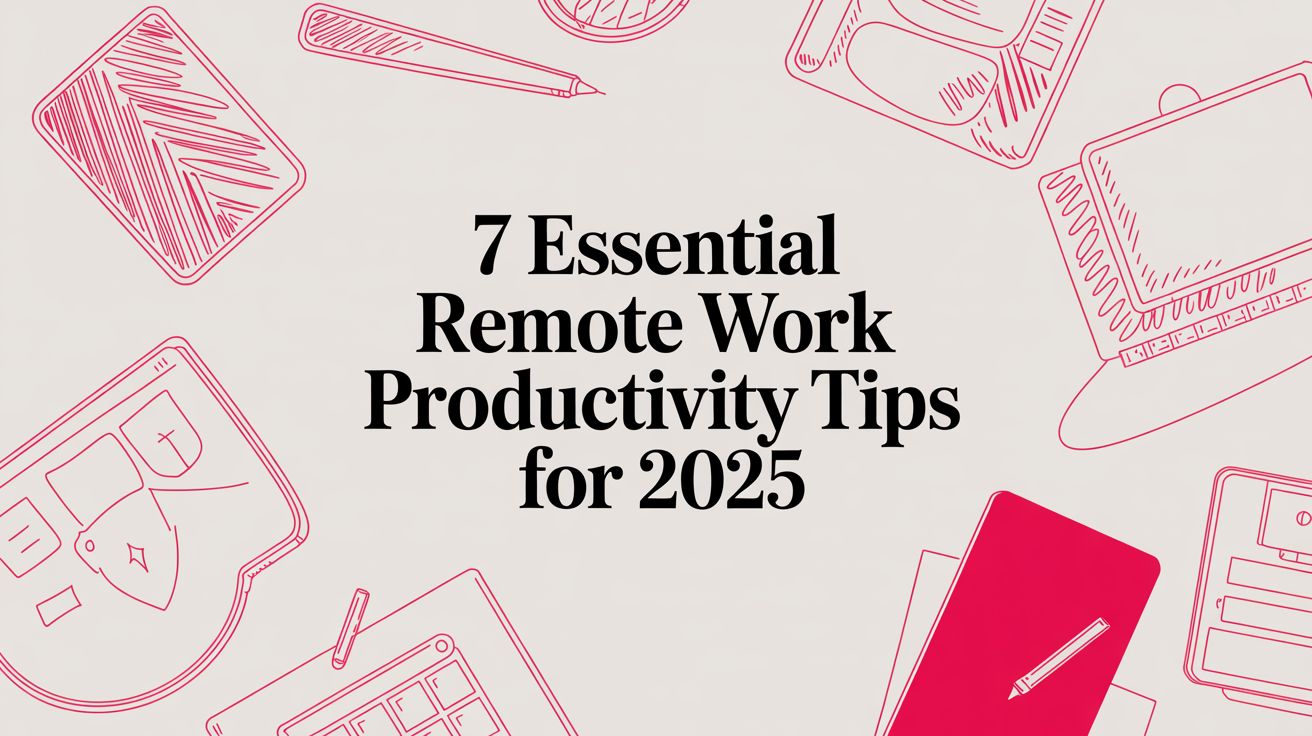8 Remote-First Employer Branding Best Practices for 2025
Max
In the competitive landscape of remote work, attracting top talent requires more than just offering a flexible schedule. A powerful employer brand, your company’s reputation as a place to work, is the ultimate differentiator. It’s the story you tell that convinces a highly skilled professional to choose you over a competitor, even when compensation packages are similar. For distributed teams, this brand is built entirely through digital touchpoints, making a strategic approach essential.
This guide moves beyond generic advice to provide actionable employer branding best practices specifically tailored for a remote-first world. We will explore how to define your unique value, leverage authentic employee voices, and create an irresistible digital presence that resonates with the best remote candidates globally. You will learn to transform your company culture into a compelling narrative that attracts, engages, and retains top-tier talent without relying on a physical office. Mastering these strategies is the key to building a thriving, distributed workforce and securing a decisive competitive advantage. By implementing these focused tactics, you can ensure your organization becomes a magnet for the talent it needs to succeed.
1. Define and Communicate Your Employee Value Proposition (EVP)
Your Employee Value Proposition (EVP) is the cornerstone of your employer branding strategy. It’s the unique promise you make to employees in return for their commitment and skills. This goes far beyond salary; it encompasses the complete experience of working for your company, including your culture, career opportunities, and the impact of the work itself. For remote-first organizations, a well-defined EVP is critical for attracting talent that thrives in an autonomous environment.
A strong EVP clearly answers the question, “Why should I work here instead of somewhere else?” It acts as a filter, attracting candidates who align with your core values while deterring those who would not be a good fit. This alignment is a key driver of engagement and a foundational element for improving long-term staff loyalty. For a deeper dive into this topic, explore these strategies for how to improve employee retention.

How to Implement a Powerful EVP
To build an authentic and compelling EVP, you must look inward first. This isn’t a marketing slogan created in a boardroom; it’s a reflection of your company’s reality.
- Conduct Internal Research: Start by surveying current employees and conducting focus groups. Ask what they value most about their work, what keeps them at the company, and what initially attracted them. This qualitative data is invaluable for uncovering authentic themes.
- Analyze Competitors: Audit the EVPs of your direct competitors and other companies vying for the same talent pool. Identify gaps and opportunities to differentiate your brand. What unique value can you offer that they don’t?
- Segment and Tailor: Consider creating specific EVP variations for different employee segments. For example, the value proposition for an entry-level software engineer might emphasize mentorship and learning, while the one for a senior sales leader could focus on autonomy and impact.
- Test and Refine: Before a public launch, test your EVP messaging with a trusted group of current employees. Ensure it resonates and feels genuine. Use their feedback to refine the language and core pillars.
A well-crafted EVP, consistently communicated across your careers page, job descriptions, and social media, is one of the most effective employer branding best practices for building a dedicated, high-performing remote team.
2. Leverage Employee Advocacy and Authentic Storytelling
Your employees are your most credible brand ambassadors, and their authentic voices carry far more weight than corporate messaging. Employee advocacy is the practice of encouraging and empowering your team to share their positive experiences, insights, and stories about working at your company. This organic, peer-to-peer marketing is a cornerstone of modern employer branding best practices, building a layer of trust that polished ad campaigns simply cannot replicate.
This approach transforms your workforce into a powerful network of storytellers. When a potential candidate sees a current employee genuinely sharing their enthusiasm for your remote culture, it resonates deeply. For remote teams, where physical office cues are absent, these digital testimonials are essential for conveying the real employee experience. To amplify your message, consider leveraging authentic employee stories and user-generated content, finding inspiration from these powerful user-generated content examples.

How to Foster Authentic Employee Advocacy
Building a successful advocacy program requires structure and support, not just a mandate to post. The goal is to make sharing easy, rewarding, and natural for your team.
- Provide Content and Guidelines: Equip employees with a library of pre-approved content, key messaging points, and branded assets. Offer clear social media guidelines but encourage personalization to keep their posts authentic to their own voice.
- Focus on Storytelling: Guide employees to share specific stories rather than generic promotional content. A post about overcoming a challenge with team support is more impactful than one simply stating “we have a great culture.” This authenticity is vital for building trust in virtual teams.
- Recognize and Reward Participation: Acknowledge and celebrate your most active advocates. This can be done through internal shout-outs, small incentives, or gamification. Recognition shows that you value their contributions.
- Utilize Advocacy Platforms: For larger organizations, tools like Bambu or EveryoneSocial can help streamline content distribution, track engagement, and manage the program effectively, turning your brand narrative into a collective effort.
3. Optimize Digital Presence and Career Pages
In the digital-first world of remote work, your online presence is your virtual storefront for talent. A company’s website, particularly its career page and social media channels, serves as the primary touchpoint for candidates researching your organization. It’s often the first and most critical impression you make, functioning as a powerful tool to move interested individuals from passive browsers to active applicants. A well-optimized digital presence provides comprehensive, engaging, and easily accessible information that brings your employer brand to life.
An effective digital strategy showcases your culture, values, opportunities, and the real experiences of your team. It should go beyond simple job listings and act as a compelling narrative, answering a candidate’s unspoken questions about what it’s truly like to work for you. For instance, ensuring that your Careers page is informative and genuinely reflects your employer brand is a fundamental step in attracting aligned talent.

How to Implement a Candidate-Centric Digital Presence
Transforming your digital channels into talent magnets requires a strategic focus on the user experience. Your goal is to create an authentic, transparent, and frictionless journey for every potential hire.
- Show, Don’t Just Tell: Incorporate authentic employee testimonials, “day-in-the-life” videos, and blog posts from team members. HubSpot’s career page excels at this by featuring employee stories and culture videos, giving candidates a genuine glimpse into their work environment.
- Prioritize Technical Performance: Ensure your careers page has fast load speeds and is fully optimized for mobile devices, as many candidates search for jobs on their phones. A clunky, slow experience can deter even the most interested applicants.
- Simplify the Application Process: Use clear, compelling calls-to-action (“Apply Now,” “Join Our Talent Community”) and streamline the application itself. Lengthy, complicated forms are a major source of candidate drop-off.
- Be Transparent and Helpful: Include salary ranges, detailed benefits information, and a clear overview of the hiring process. Implementing a chatbot or live chat can provide immediate answers to common candidate questions, improving their experience significantly.
Optimizing your digital footprint is one of the most vital employer branding best practices, as it directly controls the narrative and experience for the vast majority of prospective candidates.
4. Create an Exceptional Candidate Experience
Your employer brand isn’t just a marketing concept; it’s a living entity experienced through every interaction a potential employee has with your company. The candidate experience encompasses the entire recruitment journey, from the moment a person discovers your job opening to their final communication with your team. A positive, respectful, and transparent process is a powerful demonstration of your company culture and values, turning applicants into brand advocates, regardless of the hiring outcome.
For remote-first companies, where in-person cues are absent, a deliberately designed candidate experience is a critical differentiator. It proves your organization is thoughtful, communicative, and values individuals’ time. This positive impression can significantly influence a top candidate’s decision, making it one of the most impactful employer branding best practices. To understand the nuances of this process, you can learn more about what is candidate experience and its impact.

How to Implement an Exceptional Candidate Experience
Crafting a memorable candidate journey requires a shift in perspective: treat your candidates with the same care and attention you give your customers. This means mapping their journey and optimizing every touchpoint for clarity and respect.
- Map the Candidate Journey: Document every step a candidate takes, from applying to receiving an offer or rejection. Identify potential friction points, such as a lengthy application form, long periods of silence, or unclear interview instructions, and actively work to resolve them.
- Prioritize Clear Communication: Set clear expectations about the hiring timeline and stick to them. Provide candidates with information about who they’ll be meeting and what to expect in each interview stage. Automate simple updates, but ensure personalized communication follows key milestones.
- Train Your Hiring Team: Your interviewers are brand ambassadors. Train them not just on how to assess skills but also on how to represent the company culture, answer questions thoughtfully, and ensure every candidate feels valued and heard.
- Actively Solicit Feedback: Use simple surveys at different stages of the process to ask candidates for their feedback. Use this data to continuously refine your approach, demonstrating that you are committed to improvement and that you respect their perspective.
5. Build Strong Social Media Strategy
A comprehensive social media strategy is a dynamic and essential component of modern employer branding best practices. It involves more than just posting job openings; it’s about creating a narrative that showcases your company culture, celebrates employee achievements, and engages directly with potential talent. This approach transforms your social channels into a vibrant window into your organization, attracting passive candidates and building a community around your brand.
For remote-first companies, social media is an especially powerful tool for conveying a sense of connection and culture that isn’t tied to a physical office. It allows you to humanize your brand and answer a key question for candidates: “What is it really like to work there?” By consistently sharing authentic content, you build trust and create a magnetic pull for individuals who align with your values and work style.
How to Implement a Powerful Social Media Strategy
Building an effective social media presence requires a strategic, multi-platform approach that prioritizes authenticity and engagement over simple broadcasting.
- Choose Platforms Wisely: Don’t try to be everywhere at once. Focus your efforts on the platforms where your target talent is most active. For instance, LinkedIn is ideal for professional content and thought leadership, while Instagram or TikTok can offer a more visual, behind-the-scenes look at your culture.
- Showcase, Don’t Just Tell: Use employee-generated content and takeovers to provide an authentic insider’s perspective. Feature team members, highlight their projects, and share their stories. For example, Shopify excels at using Instagram to showcase employee diversity and company events, creating a relatable and appealing brand image.
- Maintain a Consistent Voice: Your tone should be consistent across all platforms, whether it’s professional and insightful like Salesforce on LinkedIn or witty and engaging like Wendy’s on Twitter. This consistency reinforces your brand identity.
- Engage and Interact: Go beyond posting by actively participating in industry conversations, responding to comments, and engaging with relevant hashtags. This increases your visibility and shows that you are an active member of your professional community.
To efficiently manage your employer branding messages across platforms, explore how social media automation software can streamline your processes, ensuring consistent and timely content delivery.
6. Implement Data-Driven Measurement and Analytics
Moving beyond gut feelings to a data-driven approach is essential for modern employer branding. This practice involves systematically collecting, analyzing, and acting on metrics to measure the effectiveness of your brand initiatives. Using both quantitative and qualitative data helps you understand brand perception, track progress toward goals, and ultimately demonstrate the return on investment (ROI) to leadership.
A data-centric strategy allows you to make evidence-based decisions and continuously optimize your efforts. For example, IBM tracks its employer brand health through sentiment analysis, Glassdoor ratings, and application quality metrics, enabling them to pinpoint and address issues proactively. This is one of the most critical employer branding best practices for ensuring your strategy remains effective and aligned with business objectives. For more insights on building a strong remote culture, review these best practices for remote teams.
How to Implement Data-Driven Measurement
To build an effective measurement framework, focus on metrics that directly connect your employer brand activities to tangible business outcomes like hiring quality and retention.
- Establish Key Metrics: Start by selecting 3-5 key metrics that align with your primary goals. These could include cost-per-hire, time-to-fill, offer acceptance rate, new hire quality, and employee Net Promoter Score (eNPS).
- Utilize Social Listening: Implement social listening tools to monitor brand mentions, track sentiment across platforms like LinkedIn and Glassdoor, and understand public perception of your company as an employer.
- Conduct Regular Surveys: Deploy regular internal surveys (like eNPS or pulse surveys) to gauge employee satisfaction and brand advocacy. Use exit interview data to understand why people leave and identify perception gaps.
- Create Leadership Dashboards: Develop clear, concise reporting dashboards that visualize your key metrics. Regularly present these findings to leadership to demonstrate the impact of your branding efforts and secure ongoing support.
7. Foster Internal Culture Alignment
An employer brand that exists only on a careers page is a hollow promise. True employer branding best practices demand that your external message is a direct reflection of your internal reality. Fostering internal culture alignment ensures that the brand you promote is the brand your employees actually experience every day. This alignment turns your team into your most powerful and authentic brand advocates.
This practice is about intentionally building and reinforcing a workplace culture where values are not just posters on a wall but are lived out in daily behaviors, decisions, and interactions. When your internal culture matches your external promise, you create a powerful cycle of attraction and retention. For a deeper look at building this environment, explore our guide to creating a thriving remote work culture.
How to Implement Strong Culture Alignment
Achieving alignment requires a deliberate, ongoing effort from leadership and every team member. It starts with defining your desired culture and then systematically embedding it into the fabric of your organization.
- Conduct Regular Culture Audits: Start by assessing the gap between your desired culture and the current reality. Use anonymous surveys, focus groups, and one-on-one interviews to understand what employees truly feel and experience. This provides a baseline for targeted improvements.
- Integrate Culture into Hiring: Move beyond assessing just skills and experience. Incorporate behavioral interview questions designed to gauge a candidate’s alignment with your core values. This ensures you’re hiring people who will contribute positively to the culture, not detract from it.
- Provide Continuous Reinforcement: Culture isn’t built in a day. Use your onboarding process to immerse new hires in your company’s values and norms. Reinforce these principles in all-hands meetings, performance reviews, and internal communications.
- Recognize and Reward Value-Driven Behavior: Actively celebrate employees who exemplify your cultural values. Public recognition and performance-based rewards tied to cultural contributions show the entire team what is truly valued, encouraging others to follow suit.
8. Develop Strategic Partnerships and Community Engagement
Building an influential employer brand extends beyond your company’s digital footprint and into the communities you serve. Strategic partnerships and community engagement involve creating meaningful relationships with educational institutions, professional associations, and nonprofit organizations. This approach showcases your company’s values in action, transforming your brand from a corporate entity into a valued community member. For remote-first companies, this demonstrates a commitment to making a positive impact that transcends geographical office locations.
This practice is one of the most effective employer branding best practices for creating alternative talent pipelines and fostering goodwill. By aligning with organizations that share your mission, you organically connect with individuals who are already invested in your values. This proactive engagement builds brand advocacy and shows potential candidates that your company is committed to more than just its bottom line. It answers the question, “Does this company care about the same things I do?”
How to Implement Strategic Partnerships
Authentic community engagement requires a long-term vision, not a transactional mindset. The goal is to build genuine, mutually beneficial relationships that reflect your core values.
- Align Partnerships with Company Values: Identify organizations whose missions resonate with your company’s purpose and talent needs. For example, a tech company focused on accessibility could partner with nonprofits supporting developers with disabilities.
- Empower Employee Involvement: Encourage and support employees to volunteer or act as ambassadors for your partner organizations. Sharing their experiences through company blogs or social media provides powerful, authentic content that humanizes your brand.
- Develop Long-Term Relationships: Focus on sustained collaboration rather than one-off sponsorships. Consider co-hosting workshops, creating mentorship programs, or offering pro bono services. Accenture’s long-standing partnerships with historically black colleges and universities (HBCUs) are a prime example of building deep, impactful talent pipelines.
- Showcase the Impact: Communicate the stories and results of your partnerships across your employer branding channels. Highlight the positive community impact and the employees involved to demonstrate your company’s commitment in a tangible way.
Employer Branding Best Practices Comparison
| Strategy | Implementation Complexity 🔄 | Resource Requirements ⚡ | Expected Outcomes 📊 | Ideal Use Cases 💡 | Key Advantages ⭐ |
|---|---|---|---|---|---|
| Define and Communicate Your Employee Value Proposition (EVP) | High – requires cross-functional input and iterative development | High – time, employee input, leadership commitment | Strong employee retention, attraction of aligned candidates | Organizations wanting to differentiate employer brand deeply | Improves engagement and retention; reduces hiring costs |
| Leverage Employee Advocacy and Authentic Storytelling | Medium – requires employee participation and ongoing enablement | Medium – training, content support programs | Expanded reach, trusted messaging, increased engagement | Companies aiming for authentic, organic brand amplification | Trusted, cost-effective content; boosts employee ownership |
| Optimize Digital Presence and Career Pages | Medium-High – involves technical SEO, content creation, UX design | High – tech and content investment | Increased candidate quality and application rates | Organizations targeting global talent with digital recruitment | 24⁄7 accessibility; improves candidate experience and SEO |
| Create Exceptional Candidate Experience | High – requires process redesign, training, tech adoption | High – resources for communication, tech, training | Enhanced employer brand and faster hiring with better acceptance | High-volume or competitive talent markets | Builds brand advocacy; reduces time-to-hire and drop-off rates |
| Build Strong Social Media Strategy | Medium – requires ongoing content creation and platform management | Medium – content, community management | Increased brand awareness and real-time engagement | Talent attraction through targeted social platforms | Cost-effective reach; supports relationship-building and analytics |
| Implement Data-Driven Measurement and Analytics | High – requires analytics tools, data collection and analysis | High – investment in systems and expertise | Evidence-based decisions and demonstrated ROI | Organizations focusing on optimizing employer brand impact | Enables strategy optimization and competitive benchmarking |
| Foster Internal Culture Alignment | High – needs leadership buy-in and culture initiatives | Medium-High – leadership time, training, programs | Authentic employer brand and improved employee advocacy | Companies seeking alignment between brand promise and reality | Reduces brand-reality gaps; long-term engagement and retention |
| Develop Strategic Partnerships and Community Engagement | Medium-High – requires relationship building and long-term focus | Medium – resources for partnership management | Expanded talent pipelines and enhanced reputation | Organizations aiming for broad community and educational reach | Builds authentic connections; enhances social responsibility image |
Building an Authentic Brand for the Future of Work
Navigating the landscape of remote work requires more than just adapting processes; it demands a fundamental shift in how organizations present themselves to the world. The journey to building a magnetic remote-first employer brand is not a one-time project but a continuous, strategic commitment. As we’ve explored, this process is multifaceted, weaving together your internal reality with your external promise to create a narrative that resonates deeply with top-tier remote talent.
The eight employer branding best practices detailed in this guide serve as a comprehensive roadmap. They move beyond superficial perks to the core of what makes an organization a truly exceptional place to work from anywhere. From articulating a powerful and authentic Employee Value Proposition (EVP) to harnessing the genuine voices of your current team members, each practice is a critical building block. Success lies in the consistent application of these strategies, ensuring every touchpoint, from your career page to a candidate’s final interview, reflects the vibrant, supportive, and dynamic culture you’ve built.
Key Takeaways for Lasting Impact
To truly embed these principles, focus on three core pillars of action:
- Authenticity is Non-Negotiable: Your brand must be a true reflection of your company culture. Aligning your internal employee experience with your external marketing messages is the most powerful strategy you can employ. When what you say matches what your employees live, you build trust and credibility that no marketing budget can buy.
- Data is Your Compass: Don’t guess what’s working. Implementing a data-driven approach to your employer branding efforts is essential. Track metrics like application rates, time-to-hire, offer acceptance rates, and employee engagement scores to understand your impact, identify areas for improvement, and demonstrate ROI to leadership.
- Consistency Creates Recognition: Your brand voice, visual identity, and core messaging must be consistent across all platforms. Whether a candidate discovers you on LinkedIn, reads a blog post, or interacts with a recruiter, their experience should feel cohesive and unified. This consistency builds a strong, recognizable, and trustworthy brand identity.
Your Next Steps to Becoming a Top Remote Employer
The future of work is here, and the competition for premier remote talent is fierce. The companies that will win are those that invest proactively in building an authentic, transparent, and compelling employer brand. Start by auditing your current efforts against the practices outlined here. Identify one or two key areas for immediate improvement, whether it’s optimizing your digital presence or launching an employee advocacy program.
By diligently applying these employer branding best practices, you are not just filling open roles; you are building a sustainable talent pipeline and a resilient organizational culture. You are creating a legacy as a destination employer where the world’s best professionals can do their most meaningful work, regardless of location. This strategic investment will pay dividends for years to come, strengthening your ability to innovate, grow, and lead in the remote-first era.
Ready to ensure your powerful employer brand reaches the right audience? Posting your remote roles on a specialized platform is the crucial final step. Remote First Jobs connects you directly with a global community of skilled professionals actively seeking opportunities at forward-thinking, remote-first companies like yours. Visit Remote First Jobs to showcase your brand to the talent that will drive your future success.


